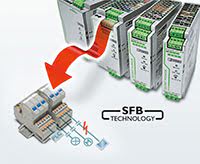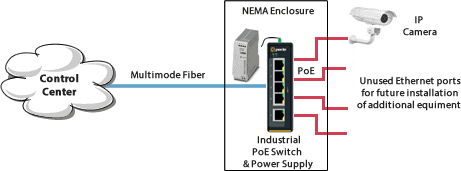QUINT-PS/1AC/CO: Alimentatore per Guida DIN Monofase
Per condizioni ambientali estreme
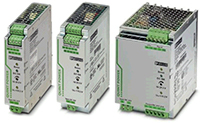
- Tensione di uscita 24 V DC
- Output Correnti: 5, 10 o 20 A
- Output Watt: 120, 240 o 480 W
- Ingresso AC o DC monofase
- Gamma tensioni di ingresso: da 85 a 264 V AC e da 96 a 430 V DC
L'alimentatore industriale QUINT-PS/1AC/CO è stato progettato appositamente per operare in luoghi industriali pericolosi e in condizioni ambientali estreme. Con numerose certificazioni, incluse ATEX e ANSI/ISA 12.12 Classe 1 Divisione 2, si avrà la certezza di un funzionamento sicuro e affidabile in luoghi in cui si movimentano, lavorano o utilizzano gas, liquidi o vapori infiammabili. Inoltre, il rivestimento in PCB protegge da polvere, gas corrosivi e umidità al 100%, oltre che dai guasti causati da correnti di dispersione non relative alla corrosione e migrazione elettrochimica.
Industrial Temperatura di esercizio da -40°C a +70°C
Le apparecchiature che si trovano nei dispositivi di gestione del traffico, nelle tubazioni di trasporto petrolio e gas, di tracciamento meteorologico, in applicazioni industriali e in ambienti esterni devono funzionare a temperature non supportate dagli alimentatori disponibili in commercio. Dotato di componenti protetti entro un intervallo di temperature di esercizio tra -40°C e 70°C, l'alimentatore industriale QUINT-PS/1AC/CO è l'ideale per l'uso con apparecchiature in ambienti difficili soggette a temperature estreme.
Gli Alimentatori Industriali per Guida DIN QUINT-PS/1AC/CO sono robusti convertitori AC o da DC a DC 24 V costruiti per soddisfare le aspettative di alta stabilità ed efficienza degli ambienti di controllo industriali, di automazione macchine e controllo di processo. Possiedono anche una combinazione unica di monitoraggio funzionale preventivo e riserva di potenza, in una dimensione incredibilmente compatta. Questi alimentatori a commutazione (in modalità commutata) garantiscono una tensione di uscita costante anche in caso di oscillazioni della tensione sulla rete di alimentazione. Durante il funzionamento in parallelo e quando connessi a fasi diverse, i carichi vengono alimentati anche in caso di problemi con la tensione di ingresso. Dotati di tutte le certificazioni di sicurezza richieste per supportare apparecchiature ITE (Information Technology Equipment), un involucro robusto, temperature di esercizio estese, capacità di carico di picco elevate e alte tensioni di isolamento, gli alimentatori industriali QUINT sono concepiti per soddisfare le esigenze di svariate applicazioni industriali.
Gamma tensioni di uscita regolabile da 18 a 29,5 V DC
Tramite il potenziometro rotativo sul frontalino dell'alimentatore QUINT, è possibile regolare in maniera ottimale la tensione di uscita per soddisfare gli specifici requisiti di qualsiasi ambiente applicativo. Ad esempio, semplifica la regolazione per compensare la caduta di tensione causata dall'elevata lunghezza di un cavo.

SOVRALIMENTAZIONE: avvio di carichi difficili in modo affidabile
Per configurare, ottimizzare ed espandere grandi sistemi è richiesto un elevato livello di flessibilità. Per adattare in modo ottimale un sistema o una macchina ai propri requisiti, è fondamentale avere una riserva di potenza nell'unità di alimentazione. L'alimentatore QUINT eroga fino al 50% di corrente in più senza caduta di tensione. Risulta utile quando non è possibile prevedere quali carichi saranno attivati contemporaneamente o se le alte correnti di inserzione dei carichi capacitivi devono essere assorbite senza cali di tensione.
Il monitoraggio funzionale preventivo segnala condizioni di funzionamento critiche prima che si verifichino
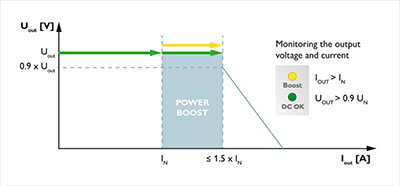
Con un alimentatore industriale QUINT, tensione di uscita e corrente di uscita sono costantemente monitorate. Il monitoraggio funzionale preventivo visualizza le condizioni operative critiche e le indica in locale e in remoto al controller, secondo le seguenti modalità:
- Tramite LED
- Tramite contatto di relè flottante
- Tramite uscita di commutazione attiva
Alta efficienza e basso consumo di potenza senza carico
Rispetto agli altri prodotti sul mercato, l'alimentatore industriale QUINT offre eccellenti risparmi energetici. Con un consumo energetico senza carico ridotto e alta efficienza a carico nominale, solo una piccola quantità di energia elettrica viene convertita in energia termica indesiderata, rendendo questi alimentatori estremamente ecologici.

Tecnologia SFB (Selective Fuse Breaking, interruzione selettiva a fusibile)
La tecnologia SFB può essere adottata per far scattare in modo rapido e affidabile interruttori disgiuntori miniaturizzati e i fusibili collegati sul secondario. In caso di cortocircuito sul secondario, l'alimentatore QUINT eroga fino a 6 volte la corrente nominale per 15 ms. I percorsi di corrente difettosi vengono disattivati selettivamente, il guasto localizzato e i componenti importanti del sistema rimangono in funzione. I carichi collegati in parallelo continuano a essere alimentati con energia, garantendone il funzionamento costante.
- Scatto degli interruttori disgiuntori: l'interruttore disgiuntore tipicamente viene fatto scattare dall'elevata corrente SFB entro 3-5 ms. Di conseguenza, ogni caduta di tensione per i carichi collegati in parallelo viene evitata.
- Scatto di un fusibile: i fusibili vengono fatti scattare fondendo il punto di rottura prestabilito all'interno della capsula del fusibile. La caratteristica di scatto del fusibile è descritta dall'integrale della fusione (I²t). Per ottenere un tempo di scatto molto breve, è fondamentale avere una corrente elevata.
Ambienti di Applicazione ideali per un Alimentatore per Guida DIN QUINT
- Costruzione navale
- Settore ferroviario
- Applicazioni mediche
- Ambienti DeviceNet
- costruzione di macchine
- processo di produzione automatizzato
- apparecchiature di controllo industriale, automazione, assemblaggio e test
- controllo, sicurezza e sorveglianza di edifici e sistemi di controllo del clima.
- alimenta innumerevoli dispositivi di automazione industriali, quali sensori, controller e valvole
Altri motivi per cui scegliere l'alimentatore Industriale QUINT
- Valori MTBF (Mean Time Between Failure, tempo medio tra i guasti) elevati
- L'ingresso più resistente: elevata immunità ai disturbi, scaricatore a gas integrato (fino a 6 kV) e ad un tempo di copertura delle interruzioni di rete ≥ 20 ms
- Il design allungato e sottile permette di risparmiare spazio nella scatola di comando
- Ingresso/Uscita isolamento di tensione: 4 kV AC
- Protezioni: da cortocircuito, sovraccarico, sovratensione, temperatura eccessiva
- Settore ferroviario
- Applicazioni mediche
- Approvazioni per applicazioni ferroviarie
- Certificato DeviceNet
Specifications
HTSUS Number:
QUINT-PS/1AC/24DC/20/CO: 8504.40.7012, QUINT-PS/1AC/24DC/10/CO: 8504.40.7012, QUINT-PS/1AC/24DC/5/CO: 8504.40.7007
UNSPSC Code:
39121004
ECCN:
EAR99
Environmental Product Compliance
REACH SVHC
QUINT-PS/ 1AC/24DC/20/CO - 23208988
Lead 7439-92-1
QUINT-PS/ 1AC/24DC/ 5/CO - 23209088
Lead 7439-92-1
QUINT-PS/ 1AC/24DC/10/CO - 23209118
Lead 7439-92-1
China RoHS
Environmentally Friendly Use Period = 25;
Environmentally Friendly Use Period = 25;
Environmentally Friendly Use Period = 25;
General
Net weight
QUINT-PS/ 1AC/24DC/20/CO - 23208988
1.7 kg
QUINT-PS/ 1AC/24DC/ 5/CO - 23209088
0.7 kg
QUINT-PS/ 1AC/24DC/10/CO - 23209118
1.1 kg
Efficiency
QUINT-PS/ 1AC/24DC/20/CO - 23208988
> 93 % (for 230 V AC and nominal values)
QUINT-PS/ 1AC/24DC/ 5/CO - 23209088
> 90 % (for 230 V AC and nominal values)
QUINT-PS/ 1AC/24DC/10/CO - 23209118
> 92.5 % (for 230 V AC and nominal values)
Insulation voltage input/output
- 4 kV AC (type test)
- 2 kV AC (routine test)
Insulation voltage input / PE
- 3.5 kV AC (type test)
- 2 kV AC (routine test)
Insulation voltage output / PE
500 V DC (routine test)
Protection class
I
Degree of protection
IP20
MTBF (IEC 61709, SN 29500)
QUINT-PS/ 1AC/24DC/20/CO - 23208988
> 900000 Hours (25°C)
> 520000 Hours (40°C)
QUINT-PS/ 1AC/24DC/ 5/CO - 23209088
> 1134000 Hours (25°C)
> 635000 Hours (40°C)
QUINT-PS/ 1AC/24DC/10/CO - 23209118
> 940000 Hours (25°C)
> 530000 Hours (40°C)
> 230000 Hours (40°C)Mounting position
horizontal DIN rail NS 35, EN 60715
Assembly instructions
alignable: PN ≥50%,
5 mm horizontally
15 mm next to active components
50 mm vertically alignable: PN <50%
0 mm horizontally
40 mm vertically top
20 mm vertically bottom
Standards and Regulations
Electromagnetic compatibility
Conformance with EMC Directive 2014/30/EU
Noise emission
EN 55011 (EN 55022)
Noise immunity
EN 61000-6-2:2005
Connection in acc. with standard
CSA
Standards/regulations
EN 61000-4-2
Contact discharge
4 kV (Test Level 2)
Standards/regulations
EN 61000-4-3
Frequency range
80 MHz ... 1 GHz
Test field strength
10 V/m (Test Level 3)
Frequency range
1.4 GHz ... 2 GHz
Test field strength
3 V/m (Test Level 2)
Standards/regulations
EN 61000-4-4
Comments
Criterion B
Standards/regulations
- EN 61000-6-3
- EN 61000-4-6
Frequency range
0.15 MHz ... 80 MHz
Voltage
10 V (Test Level 3)
Low Voltage Directive
Conformance with LV directive 2006/95/EC
Standard - Electrical safety
IEC 60950-1/VDE 0805 (SELV)
Standard – Electronic equipment for use in electrical power installations and their assembly into electrical power installations
EN 50178/VDE 0160 (PELV)
Standard – Safety extra-low voltage
IEC 60950-1 (SELV) and EN 60204-1 (PELV)
Standard - Safe isolation
DIN VDE 0100-410
Standard – Limitation of mains harmonic currents
EN 61000-3-2
Standard - Equipment safety
BG (design tested)
Shipbuilding approval
QUINT-PS/ 1AC/24DC/20/CO - 23208988
DNV GL (EMC B, only with upstream filter)
QUINT-PS/ 1AC/24DC/ 5/CO - 23209088
DNV GL (EMC A)
QUINT-PS/ 1AC/24DC/10/CO - 23209118
DNV GL (EMC B), ABS, LR, RINA, NK, BV
UL approvals
- UL/C-UL listed UL 508
- UL/C-UL Recognized UL 60950-1
- UL ANSI/ISA-12.12.01 Class I, Division 2, Groups A, B, C, D (Hazardous Location)
DeviceNet approval
DeviceNet™ Power Supply Conformance Tested
Shock
18 ms, 30g, in each space direction (according to IEC 60068-2-27)
Vibration (operation)
- < 15 Hz, amplitude ±2.5 mm (according to IEC 60068-2-6)
- 15 Hz ... 150 Hz, 2.3g, 90 min.
Approval - requirement of the semiconductor industry with regard to mains voltage dips
SEMI F47-0706 Compliance Certificate
Information technology equipment - safety (CB scheme)
IEC 60950-1 (2nd Edition)
Rail applications
EN 50121-4
Noxious gas test
ISA-S71.04-1985 G3 Harsh Group A
ATEX
- II 3 G Ex nA nC IIC T4 Gc
- SIQ 14 ATEX 137 X
IECEx
QUINT-PS/ 1AC/24DC/20/CO - 23208988
- Ex nA nC IIC T4 Gc
- IECEx SIQ 14.0001X
QUINT-PS/ 1AC/24DC/ 5/CO - 23209088
- Ex nA nC IIC T4 Gc
- IECEx TUN 11.0002X
QUINT-PS/ 1AC/24DC/10/CO - 23209118
- Ex nA nC IIC T4 Gc
- IECEx TUN 11.0007X
Overvoltage category
(EN 62477-1)
III
Connection data, input
Connection method
QUINT-PS/ 1AC/24DC/20/CO - 23208988
Screw connection
QUINT-PS/ 1AC/24DC/ 5/CO - 23209088
Pluggable screw connection
QUINT-PS/ 1AC/24DC/10/CO - 23209118
Pluggable screw connection
Conductor cross section solid min.
0.2 mm²
Conductor cross section solid max.
QUINT-PS/ 1AC/24DC/20/CO - 23208988
6 mm²
QUINT-PS/ 1AC/24DC/ 5/CO - 23209088
2.5 mm²
QUINT-PS/ 1AC/24DC/10/CO - 23209118
2.5 mm²
Conductor cross section flexible min.
0.2 mm²
Conductor cross section flexible max.
QUINT-PS/ 1AC/24DC/20/CO - 23208988
4 mm²
QUINT-PS/ 1AC/24DC/ 5/CO - 23209088
2.5 mm²
QUINT-PS/ 1AC/24DC/10/CO - 23209118
2.5 mm²
Conductor cross section AWG min.
QUINT-PS/ 1AC/24DC/20/CO - 23208988
18
QUINT-PS/ 1AC/24DC/ 5/CO - 23209088
20
QUINT-PS/ 1AC/24DC/10/CO - 23209118
16
Conductor cross section AWG max.
QUINT-PS/ 1AC/24DC/20/CO - 23208988
10
QUINT-PS/ 1AC/24DC/ 5/CO - 23209088
12
QUINT-PS/ 1AC/24DC/10/CO - 23209118
12
Stripping length
7 mm
Screw thread
QUINT-PS/ 1AC/24DC/20/CO - 23208988
M4
QUINT-PS/ 1AC/24DC/ 5/CO - 23209088
M3
QUINT-PS/ 1AC/24DC/10/CO - 23209118
M3
Output data
Nominal output voltage
24 V DC ±1 %
Setting range of the output voltage (USet)
18 V DC ... 29.5 V DC (> 24 V DC, constant capacity restricted)
Nominal output current (IN)
QUINT-PS/ 1AC/24DC/20/CO - 23208988
20 A (-25 °C ... 60 °C, UOUT = 24 V DC)
QUINT-PS/ 1AC/24DC/ 5/CO - 23209088
5 A (-25 °C ... 60 °C, UOUT = 24 V DC)
QUINT-PS/ 1AC/24DC/10/CO - 23209118
10 A (-25 °C ... 60 °C, UOUT = 24 V DC)
POWER BOOST (IBoost)
QUINT-PS/ 1AC/24DC/20/CO - 23208988
26 A (-25°C ... 40°C permanent, UOUT = 24 V DC)
QUINT-PS/ 1AC/24DC/ 5/CO - 23209088
7.5 A (-25°C ... 40°C permanent, UOUT = 24 V DC)
QUINT-PS/ 1AC/24DC/10/CO - 23209118
15 A (-25°C ... 40°C permanent, UOUT = 24 V DC)
Selective Fuse Breaking (ISFB)
QUINT-PS/ 1AC/24DC/20/CO - 23208988
120 A (12 ms)
QUINT-PS/ 1AC/24DC/ 5/CO - 23209088
30 A (12 ms)
QUINT-PS/ 1AC/24DC/10/CO - 23209118
60 A (12 ms)
Derating
60°C ... 70°C (2.5%/K)
Connection in parallel
Yes, for redundancy and increased capacity
Connection in series
Yes
Feedback resistance
max. 35 V DC
Protection against surge voltage on the output
< 32 V DC
Control deviation
- < 1 % (change in load, static 10 % ... 90 %)
- < 2 % (change in load, dynamic 10 % ... 90 %)
- < 0.1 % (change in input voltage ±10 %)
Residual ripple
QUINT-PS/ 1AC/24DC/20/CO - 23208988
< 30 mVPP (with nominal values)
QUINT-PS/ 1AC/24DC/ 5/CO - 23209088
< 40 mVPP (with nominal values)
QUINT-PS/ 1AC/24DC/10/CO - 23209118
< 50 mVPP (with nominal values)
Output power
QUINT-PS/ 1AC/24DC/20/CO - 23208988
480 W
QUINT-PS/ 1AC/24DC/ 5/CO - 23209088
120 W
QUINT-PS/ 1AC/24DC/10/CO - 23209118
240 W
Typical response time
QUINT-PS/ 1AC/24DC/20/CO - 23208988
< 0.6 s
QUINT-PS/ 1AC/24DC/ 5/CO - 23209088
< 0.15 s
QUINT-PS/ 1AC/24DC/10/CO - 23209118
< 0.15 s
Maximum power dissipation in no-load condition
QUINT-PS/ 1AC/24DC/20/CO - 23208988
8 W
QUINT-PS/ 1AC/24DC/ 5/CO - 23209088
3 W
QUINT-PS/ 1AC/24DC/10/CO - 23209118
9.1 W
Power loss nominal load max.
QUINT-PS/ 1AC/24DC/20/CO - 23208988
40 W
QUINT-PS/ 1AC/24DC/ 5/CO - 23209088
15 W
QUINT-PS/ 1AC/24DC/10/CO - 23209118
22 W
Connection data for signaling
Conductor cross section solid min.
0.2 mm²
Conductor cross section solid max.
QUINT-PS/ 1AC/24DC/20/CO - 23208988
6 mm²
QUINT-PS/ 1AC/24DC/ 5/CO - 23209088
2.5 mm²
QUINT-PS/ 1AC/24DC/10/CO - 23209118
2.5 mm²
Conductor cross section flexible min.
0.2 mm²
Conductor cross section flexible max.
QUINT-PS/ 1AC/24DC/20/CO - 23208988
4 mm²
QUINT-PS/ 1AC/24DC/ 5/CO - 23209088
2.5 mm²
QUINT-PS/ 1AC/24DC/10/CO - 23209118
2.5 mm²
Conductor cross section AWG min.
QUINT-PS/ 1AC/24DC/20/CO - 23208988
18
QUINT-PS/ 1AC/24DC/ 5/CO - 23209088
20
QUINT-PS/ 1AC/24DC/10/CO - 23209118
16
Conductor cross section AWG max.
QUINT-PS/ 1AC/24DC/20/CO - 23208988
10
QUINT-PS/ 1AC/24DC/ 5/CO - 23209088
12
QUINT-PS/ 1AC/24DC/10/CO - 23209118
12
Screw thread
QUINT-PS/ 1AC/24DC/20/CO - 23208988
M4
QUINT-PS/ 1AC/24DC/ 5/CO - 23209088
M3
QUINT-PS/ 1AC/24DC/10/CO - 23209118
M3
Dimensions
Width
QUINT-PS/ 1AC/24DC/20/CO - 23208988
90 mm
QUINT-PS/ 1AC/24DC/ 5/CO - 23209088
40 mm
QUINT-PS/ 1AC/24DC/10/CO - 23209118
60 mm
Height
130 mm
Depth
125 mm
Width with alternative assembly
122 mm
Height with alternative assembly
130 mm
Depth with alternative assembly
QUINT-PS/ 1AC/24DC/20/CO - 23208988
93 mm
QUINT-PS/ 1AC/24DC/ 5/CO - 23209088
43 mm
QUINT-PS/ 1AC/24DC/10/CO - 23209118
63 mm
Weight per piece
QUINT-PS/ 1AC/24DC/20/CO - 23208988
1700.0 GRM
QUINT-PS/ 1AC/24DC/ 5/CO - 23209088
700.0 GRM
QUINT-PS/ 1AC/24DC/10/CO - 23209118
1100.0 GRM
Input data
Input data
- 100 V AC ... 240 V AC
- 110 V DC ... 250 V DC
Input voltage range
- 85 V AC ... 264 V AC
- 90 V DC ... 410 V DC +5 % (UL 508: ≤ 250 V DC)
Dielectric strength maximum
300 V AC
AC frequency range
45 Hz ... 65 Hz
Frequency range DC
0 Hz
Discharge current to PE
< 3.5 mA
Weight per piece
QUINT-PS/ 1AC/24DC/20/CO - 23208988
- 5.1 A (120 V AC)
- 5.1 A (120 V AC)
- 4.9 A (110 V DC)
- 2.4 A (220 V DC)
QUINT-PS/ 1AC/24DC/ 5/CO - 23209088
- 1.2 A (120 V AC)
- 0.6 A (230 V AC)
- 1.3 A (110 V DC)
- 0.6 A (220 V DC)
QUINT-PS/ 1AC/24DC/10/CO - 23209118
- 2.2 A (120 V AC)
- 1.3 A (230 V AC)
- 2.5 A (110 V DC)
- 1.2 A (220 V DC)
Nominal power consumption
QUINT-PS/ 1AC/24DC/20/CO - 23208988
569 VA
QUINT-PS/ 1AC/24DC/ 5/CO - 23209088
141 VA
QUINT-PS/ 1AC/24DC/10/CO - 23209118
303 VA
Inrush surge current
QUINT-PS/ 1AC/24DC/20/CO - 23208988
< 20 A
QUINT-PS/ 1AC/24DC/ 5/CO - 23209088
< 15 A
QUINT-PS/ 1AC/24DC/10/CO - 23209118
< 15 A
Mains buffering
QUINT-PS/ 1AC/24DC/20/CO - 23208988
- typ. 32 ms (120 V AC)
- typ. 32 ms (230 V AC)
QUINT-PS/ 1AC/24DC/ 5/CO - 23209088
- typ. 55 ms (120 V AC)
- typ. 55 ms (230 V AC)
QUINT-PS/ 1AC/24DC/10/CO - 23209118
- typ. 36 ms (120 V AC)
- typ. 36 ms (230 V AC)
Input fuse
QUINT-PS/ 1AC/24DC/20/CO - 23208988
12 A (slow-blow, internal)
QUINT-PS/ 1AC/24DC/ 5/CO - 23209088
5 A (slow-blow, internal)
QUINT-PS/ 1AC/24DC/10/CO - 23209118
10 A (slow-blow, internal)
Choice of suitable circuit breakers
QUINT-PS/ 1AC/24DC/20/CO - 23208988
10 A ... 16 A (AC: Characteristics B, C, D, K)
QUINT-PS/ 1AC/24DC/ 5/CO - 23209088
6 A ... 16 A (AC: Characteristics B, C, D, K)
QUINT-PS/ 1AC/24DC/10/CO - 23209118
10 A ... 20 A (AC: Characteristics B, C, D, K)
Type of protection
Transient surge protection
Protective circuit/component
QUINT-PS/ 1AC/24DC/20/CO - 23208988
Varistor, gas-filled surge arrester
QUINT-PS/ 1AC/24DC/ 5/CO - 23209088
Varistor
QUINT-PS/ 1AC/24DC/10/CO - 23209118
Varistor, gas-filled surge arrester
Connection data, onput
Connection method
QUINT-PS/ 1AC/24DC/20/CO - 23208988
Screw connection
QUINT-PS/ 1AC/24DC/ 5/CO - 23209088
Pluggable screw connection
QUINT-PS/ 1AC/24DC/10/CO - 23209118
Pluggable screw connection
Conductor cross section solid min.
0.2 mm²
Conductor cross section solid max.
QUINT-PS/ 1AC/24DC/20/CO - 23208988
6 mm²
QUINT-PS/ 1AC/24DC/ 5/CO - 23209088
2.5 mm²
QUINT-PS/ 1AC/24DC/10/CO - 23209118
2.5 mm²
Conductor cross section flexible min.
0.2 mm²
Conductor cross section flexible max.
QUINT-PS/ 1AC/24DC/20/CO - 23208988
4 mm²
QUINT-PS/ 1AC/24DC/ 5/CO - 23209088
2.5 mm²
QUINT-PS/ 1AC/24DC/10/CO - 23209118
2.5 mm²
Conductor cross section AWG min.
QUINT-PS/ 1AC/24DC/20/CO - 23208988
12
QUINT-PS/ 1AC/24DC/ 5/CO - 23209088
20
QUINT-PS/ 1AC/24DC/10/CO - 23209118
16
Conductor cross section AWG max.
QUINT-PS/ 1AC/24DC/20/CO - 23208988
10
QUINT-PS/ 1AC/24DC/ 5/CO - 23209088
12
QUINT-PS/ 1AC/24DC/10/CO - 23209118
12
Stripping length
7 mm
Screw thread
QUINT-PS/ 1AC/24DC/20/CO - 23208988
M4
QUINT-PS/ 1AC/24DC/ 5/CO - 23209088
M3
QUINT-PS/ 1AC/24DC/10/CO - 23209118
M3
Ambient conditions
Degree of protection
IP20
Ambient temperature (operation)
-40°C ... 70°C (> 60°C Derating: 2.5 %/K)
Ambient temperature (storage/transport)
-40°C ... 85°C
Max. permissible relative humidity (operation)
100 % (at 25 °C, non-condensing)
Climatic class
3K3 (in acc. with EN 60721)
Degree of pollution
2
Installation height
QUINT-PS/ 1AC/24DC/20/CO - 23208988
6000 m
QUINT-PS/ 1AC/24DC/ 5/CO - 23209088
5000 m
QUINT-PS/ 1AC/24DC/10/CO - 23209118
5000 m
Approvals
- ABS
- DNV GL
- BV
- RINA
- cUL Recognized
- cUL Listed
- IECEE CB Scheme
- LR
- UL Listed
- IECEE CB Scheme
- cULus Listed
- UL Recognized
- EAC
- cULus Recognized
- NK
- CSA
- Bauartgeprüft
Application Diagrams
Schema a Blocchi di Alimentazione Industriale QUINT-PS/1AC/24DC/5/CO
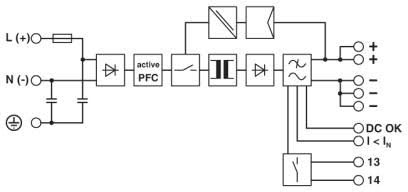
Schema a Blocchi di Alimentazione Industriale QUINT-PS/1AC/24DC/10/CO e QUINT-PS/1AC/24DC/20/CO

Fare clic sul numero di parte del prodotto per informazioni sull'ordine.
Immagine del prodotto
Descrizione
Numero parte

QUINT-PS/1AC/24DC/20/CO Power Supply - QUINT power supply for DIN rail mounting with SFB (Selective Fuse Breaking) Technology, with protective coating, input: 1-phase, output: 24 V DC/20 A

QUINT-PS/1AC/24DC/10/CO Power Supply - QUINT power supply for DIN rail mounting with SFB (Selective Fuse Breaking) Technology, with protective coating, input: 1-phase, output: 24 V DC/10 A

QUINT-PS/1AC/24DC/5/CO Power Supply - QUINT power supply for DIN rail mounting with SFB (Selective Fuse Breaking) Technology, with protective coating, input: 1-phase, output: 24 V DC/5 A

